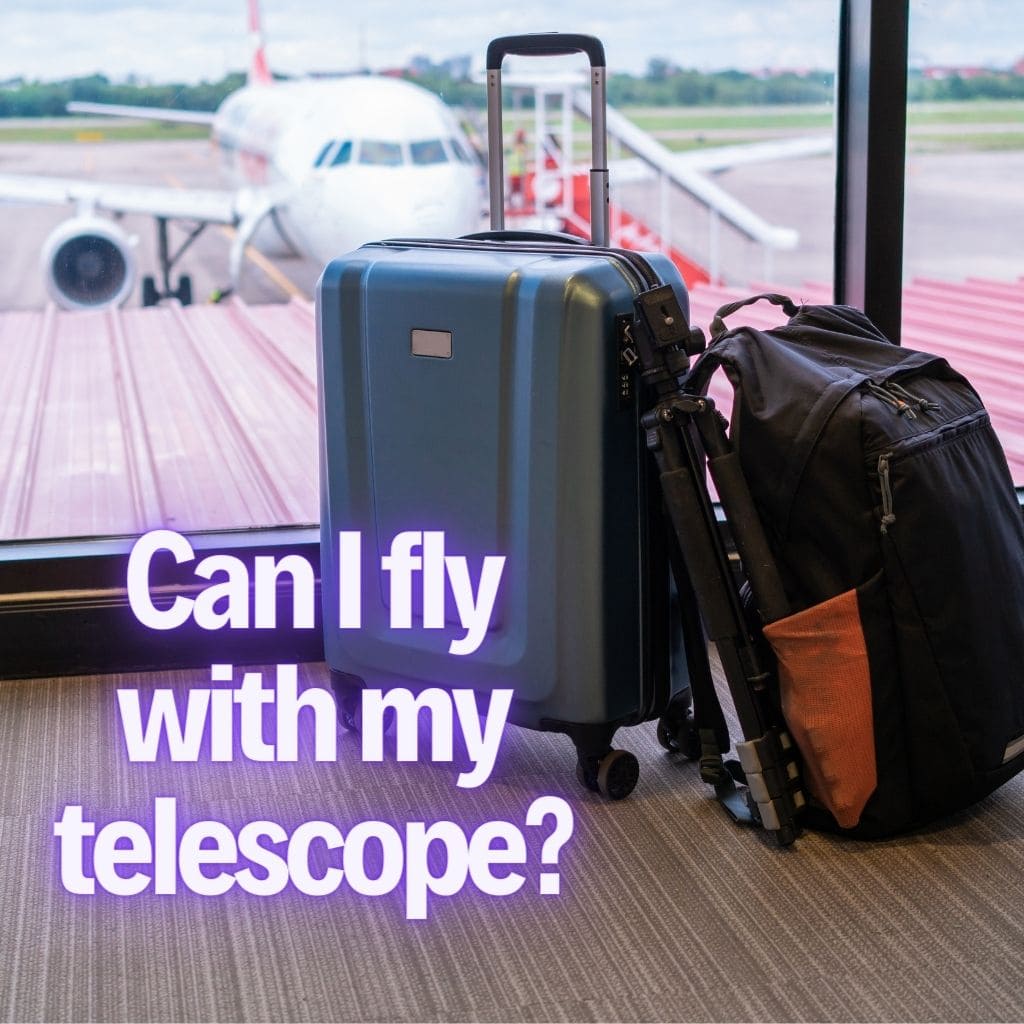This site contains affiliate links to products. I may receive a commission for purchases made through these links.
Are you planning a trip and wondering if you can take your telescope as hand luggage? Whether an amateur or professional astronomer, you’ll want to ensure your telescope is protected during transportation.
You can carry a telescope on a plane as a carry-on or checked-in baggage. However, it is highly advisable to use a carry-on method of transport to avoid damage. Your telescope must be small enough to fit into the carry-on category.
Whether a beginner or an experienced stargazer, this post will give you the knowledge you need to travel with your telescope easily.
Can I fly with my telescope?
You can fly with your telescope on major airlines, but it will depend on the size and weight of the telescope and the specific policies of the airline you are traveling with.
Telescopes need to be adequately packed and protected to ensure their safety during transportation.
When considering air travel with your telescope, it’s essential to check the specific requirements and restrictions of the airline you plan to fly with. For example, United Airlines has a specific size and weight restrictions for a carry-on bag, which must be considered when packing your telescope.
What is the best telescope for air travel?
When it comes to traveling with a telescope, choosing the right one for air travel is crucial for ensuring the safety of your equipment and making the process as seamless as possible.
We’ve compiled a list of the best telescopes for air travel, considering factors such as size, weight, durability, and ease of use for travel time.
Refractor telescopes

Check the current price on Amazon
Refractor telescopes, also known as refracting telescopes, use lenses to bend and focus light.
Refractor telescopes are an excellent option for air travel for several reasons. Firstly, they are generally smaller and lighter than other telescopes, making them more portable and easy to carry for carry-on or overhead storage.
Refractor telescopes do not require frequent realignment like other telescopes, such as reflectors. This means they are less likely to be affected by changes in temperature and humidity, which are common during air travel.
Maksutov-Cassegrain telescopes

Check the current price on Amazon
Maksutov-Cassegrain telescopes, also known as Mak-Cass telescopes, are a type of catadioptric telescope that use a combination of mirrors and lenses to focus light.
Maksutov-Cassegrain telescopes are a good option as they are relatively small and lightweight compared to other telescopes for carry-on bags or overhead storage.
Maksutov-Cassegrain telescopes are also a good option for checked luggage.
Travel scopes

Check the current price on Amazon
Travel scopes, also known as compact or portable telescopes, are specifically designed for easy transportation and quick set-up. They are generally smaller, making them more convenient for air travel within the weight limit.
They also often feature a more compact design, making them easier to pack and store in your carry-on bag.
Travel scopes are often equipped with a built-in mount, so they don’t need a separate tripod. You can also carry them in your checked-in baggage.
GoTo telescopes

Check the current price on Amazon
GoTo telescopes, also known as computerized telescopes, use a built-in computer and motorized mount to automatically point and track objects in the sky. They are designed to make it easier to find and observe celestial objects.
Furthermore, GoTo telescopes often come with a built-in mount and do not require a separate tripod, reducing the space and weight limits in your carry-on luggage and reducing the risk of damage during transportation.
More options here: 27 Best Travel Telescopes (Ranked!)
What kind of hand luggage should I use to carry my telescope?
If you’re planning to travel with your telescope, choosing the right type of hand luggage is vital. We’ve compiled a list of the best cabin bag options for carrying your telescope.
Hard-shell case

Check the current price on Amazon
A hard-shell case is a type of hand luggage designed to protect your telescope from impact and weather damage during transport. These cases are typically made from durable materials such as plastic or aluminum and have a hard, rigid exterior that can withstand significant force.
Hard-shell cases often have wheels and an extendable handle, making them easy to maneuver and transport. They also came with various locking mechanisms, such as combination locks and keyed locks, providing an added level of security for your telescope.
It is also ideal for telescopes that must be checked in as baggage and placed in the plane’s cargo compartment.
Padded carrying case

Check the current price on Amazon
A padded carrying case is a carry-on bag to protect your telescope during transport. These cases typically have a soft, padded exterior that can withstand significant force and provide cushioning for your telescope.
Padded cases often have comfortable shoulder or backpack straps, making them easy to carry. They are also lightweight, making them a good option for traveling by foot or bicycle.
Unlike backpacks, padded carrying cases can come in different designs. They have a handle or a shoulder strap that allows you to carry them like a bag.
Backpack

Check the current price on Amazon
Backpacks are considered an excellent option to carry your telescope as they are designed to be worn on the back, with straps that are adjustable to fit the wearer’s body, making them easy to carry over long distances.
Backpacks provide a good balance of protection and portability for your telescope.
Roll-aboard luggage

Check the current price on Amazon
Roll-aboard luggage, also known as rolling duffel bags or wheeled duffel bags, has wheels and an extendable handle, making it easy to maneuver and transport. They are designed to be used as carry-on luggage and typically have a large main compartment for storing your telescope and other items.
The main advantage of roll-aboard luggage is its portability and ease of use. They can often be stowed in overhead compartments on planes.
You may also like: Telescope Covers & Cases (Read before Purchase)
TSA regulations for carry on bags
The TSA (Transportation Security Administration) has specific rules and guidelines for what can and cannot be taken as carry-on luggage when traveling by air.
The TSA’s website is dedicated to traveling with unique items, including telescopes. On this page, you can find information on what items are allowed as carry-on and checked baggage and any specific requirements or restrictions.
TSA allows telescopes as carry-on baggage as long as they meet specific size and weight restrictions. Telescopes must be able to fit in the overhead storage or under the seat in front of you.
The TSA has strict regulations for batteries, and it is essential to check the TSA website for specific regulations regarding the type of battery terminals you are carrying.
It’s also important to note that TSA allows lithium-ion batteries to be carried on board, but they must be in carry-on baggage only. If the telescope has a lithium-ion battery, it must be carried on board, and the battery must be protected from damage and short circuit.
When navigating security checkpoints with your telescope, it is crucial to inform the TSA officer that you have a telescope and that it is fragile equipment. They will then take steps to properly handle the telescope during the screening process.
How do I pack my telescope for air travel as a carry or checked luggage?
Properly packing your telescope for air travel is essential to ensure that it arrives in good working condition at your destination. Here are the tips on protecting it during transport.
Use a hard-shell case or a padded, durable telephone carrying case
A hard shell or a padded, durable carrying case is the best way to protect your telescope during transport.
These cases are designed to protect your telescope from impact and weather damage, and they often come with padding and straps to secure the telescope in place.
Hard-shell cases are typically made from durable materials such as plastic or aluminum and have a hard, rigid exterior that can withstand significant force.
Remove any removable lenses or eyepieces and pack them separately
Removing any removable lenses or eyepieces from your telescope before packing can help protect them from damage during transport.
Pack these items separately in a padded bag or protective case to ensure they are not damaged or lost during your travels.
It also reduces the overall weight of the telescope and makes it easier to pack and transport.
Use bubble wrap or foam padding to protect the telescope
Bubble wrap can protect your telescope from scratches and dings, while foam padding can help prevent it from moving inside the case and provide cushioning for delicate parts.
Make sure to wrap the telescope securely, so it does not move around inside the case.
Securely fasten any moving parts or attachments
Before packing your telescope, secure any moving parts or attachments that may be prone to shifting during transport. This includes the telescope’s tripod legs, finder scope, and other attachments.
This can be done using straps, bungee cords, or tie-downs to keep the moving parts in place. This will help prevent damage caused by the parts shifting inside the case during transport.
Label the case as fragile and with contact information
Clearly labeling your telescope case as fragile can help ensure it is handled with care during transport. It is also recommended to include your contact information on the case in case it becomes separated from you during travel.
The airline or TSA can contact you to return your telescope if the case is lost or mishandled.
Tips for traveling with a telescope on a plane
Traveling with a telescope on a plane can be tricky, but with the proper preparation and planning, you can ensure that your telescope arrives at your destination in good working condition.
Here are some tips on how to travel with a telescope on a plane.
Check the airline for any specific requirements for carrying a telescope as a carry-on bag
Before traveling with your telescope, it is essential to check with the airline for any specific requirements or restrictions for carrying telescopes as a carry-on.
Check if the airline charges any additional fee for carrying telescopes as hand luggage.
Get travel insurance
Travel insurance covers the costs of any repairs or replacements that may be needed. Some insurance policies may also include coverage for medical expenses or trip cancellations.
Remember that not all insurance policies will cover telescopes or photography equipment, so it’s essential to read the fine print and look for a policy that explicitly covers cameras, telescopes, and other photography equipment.
Consider getting a TSA-approved lock for your telescope case
TSA-approved locks come with a unique code that TSA officers can use to open them without breaking them. This can provide an extra layer of security for your telescope and prevent any damage that may occur during an inspection.
They are widely available and can be found at most travel supply stores or online.
Balance and secure the telescope inside the case
Before closing the case, make sure to balance and secure the telescope inside the case. Use padding, foam, or bubble wrap to secure the telescope and prevent it from shifting inside the case.
Also, ensure that the telescope is secured with straps or tie-downs, so it does not move around inside the case.
Bring a cleaning kit and any necessary tools to maintain and adjust your telescope
A cleaning kit and any necessary tools are essential to maintaining and adjusting your telescope. This can include a lens cleaning solution, a microfiber cleaning cloth, and small tools such as screwdrivers and Allen wrenches.
It’s also good to bring a copy of your telescope’s manual in case you need to troubleshoot any issues.
Take note of the local weather conditions to protect your telescope from any potential damage
Before traveling, you must check the local weather conditions at your destination, such as temperature, humidity, and precipitation.
This information can help you prepare your telescope and protect it from any potential damage caused by extreme weather conditions.
Ready for takeoff: Learn how to safely travel with your telescope
When traveling with a telescope, it’s essential to plan and take the necessary precautions to ensure that your telescope arrives at your destination in good working condition.
By following the above tips, you can ensure that your telescope is protected during transport and is ready for use when you reach your destination.
Read more:



